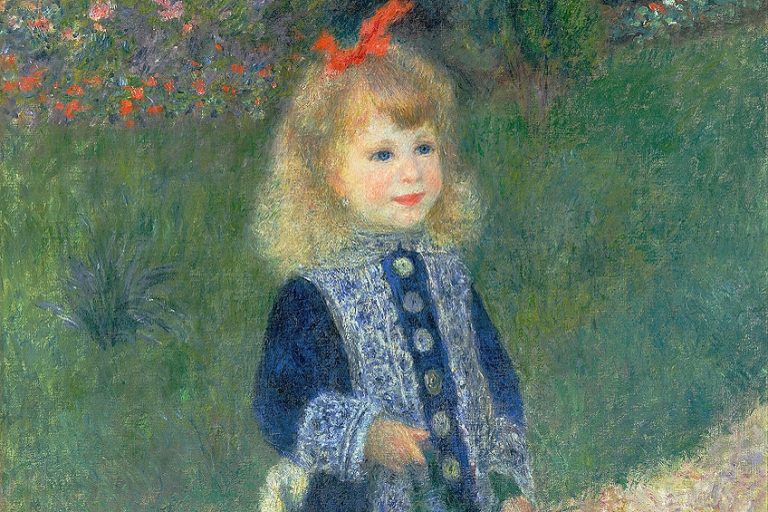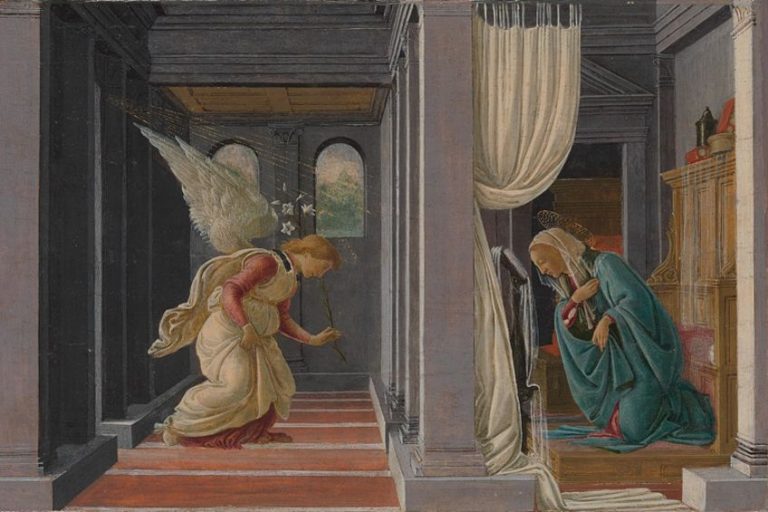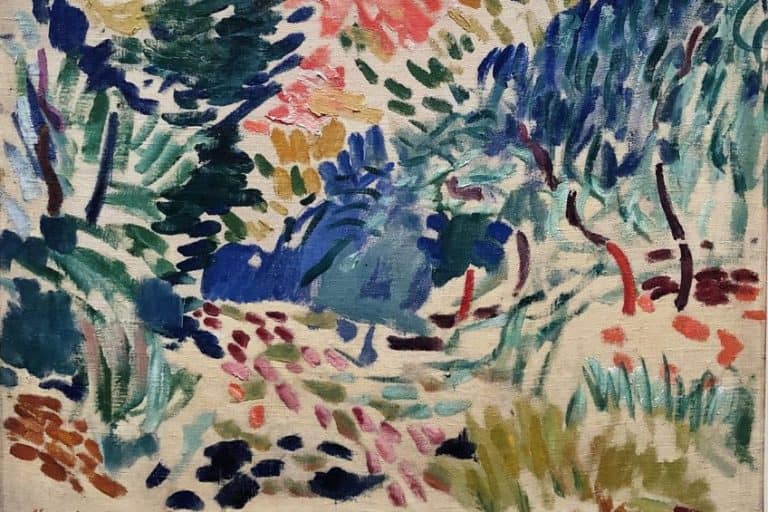Jan van Eyck The Annunciation – Analyzing the Annunciation Painting
“Now in the sixth month, the angel Gabriel was sent by God to a city of Galilee named Nazareth, to a virgin betrothed to a man whose name was Joseph, of the house of David. The virgin’s name was Mary.” This is an excerpt from the book of Luke (1: 26 to 38) in the Bible. Below, we explore this fortuitous event further in one of the most realistic painted depictions by the Northern Renaissance painter, Jan van Eyck.
Artist Abstract: Who Was Jan van Eyck?
Jan van Eyck was a Flemish painter believed to have been born between 1385 to 1390 (there have been minimal records of the artist’s actual birth date). Van Eyck is also believed to have grown up in the town of Maaseik, Belgium. He was one of the most prominent Early Northern Renaissance painters and considered by many as the “Father of Oil Painting” due to the high level of realism he depicted in his paintings. His work included being a court painter for figures like John III the Pitiless and Philip the Good (Duke of Burgundy). In 1429, van Eyck moved to Bruges where he remained until his death, which was around 1441.

Jan van Eyck, The Annunciation, in Context
In this article we will discuss the famous Annunciation painting by Flemish artist, Jan van Eyck, simply titled, The Annunciation (1434 to 1436). It is regarded as one of the most complex paintings, rich in symbolism and iconography, not to mention stylistic detail that makes it appear almost photographic. We will firstly explore the painting from a socio-historical perspective and briefly discuss its place within the period it was painted. Secondly, we will discuss the subject matter along with its symbolic and stylistic motifs.
| Artist | Jan van Eyck |
| Date Painted | c.1434 to 1436 |
| Medium | Oil on canvas (it was transferred from panel) |
| Genre | Religious Painting |
| Period | Northern Renaissance |
| Dimensions | Height: 90.20 centimeters Length: 34.10 centimeters |
| Series / Versions | Believed to be the left-wing of a triptych |
| Where is it housed? | National Gallery of Art, Washington D.C., United States |
| What It Is Worth | Not available |
Contextual Analysis: A Brief Socio-Historical Overview
The above-mentioned excerpt from the Book of Luke is also called the Annunciation, or the Annunciation of Our Lady. This Annunciation scene has been a famous subject of religious paintings ( Christian art) throughout European history.
We will find various examples of this common theme – religious subject matter – from different periods throughout art history, namely the Byzantine, Romanesque, Gothic, and especially the Renaissance periods in Italy and Northern Europe, as well as Mannerism and Russian iconographic painting.
During art periods like the Renaissance, for example, religious art was mostly commissioned by the Catholic Church. However, there were also other patrons of the arts like the wealthy Medici family in Florence and the Gonzaga family in Mantua, Italy. These patrons are important to note as they decided the subject matter too.

Some of the most common types of artworks predominantly included architecture and sculpture. Paintings would include various types like illuminated manuscripts and altarpieces, the latter of which would come in different formats, namely, diptych, triptych, and polyptych. These are also referred to as panel paintings and would usually be made of wood with oils or egg tempera paints.
Diptych panels would consist of two panels connected to one another by hinges, and this would also be foldable. Diptychs were often utilized for personal devotions and were also referred to as “traveling icons” due to their portability. Triptychs had three panels, the middle part with two “wings” hinged onto it. And polyptychs had over three panels. These were widespread in churches and tend to depict various Biblical narratives.
Van Eyck’s Annunciation painting is believed to have been part of a triptych.

Jan van Eyck also painted many other religious-themed paintings with Mother Mary as the central figure. The artist would also incorporate religious iconography and symbolism in his paintings, which originated from his strong beliefs in exploring the relationship between the material and spiritual worlds.
Some of his other prominent paintings include the triptychs entitled Ghent Altarpiece (c. 1432), Madonna in the Church(c. 1438 to 1440), Madonna of Chancellor Rolin (c. 1435), Dresden Triptych (c. 1437). Some of his famous secular artwork includes the Man in a Red Turban (1433) and The Arnolfini Portrait (1434).
Formal Analysis: A Brief Compositional Overview
The painting by Jan van Eyck, The Annunciation, is a seemingly opulent and symbol-rich depiction of the Annunciation scene. Where do we start in finding the hidden gems in this masterpiece? Below, we explore the different compositional elements and styles of this famous Flemish painter, starting with the bigger picture, the subject matter.
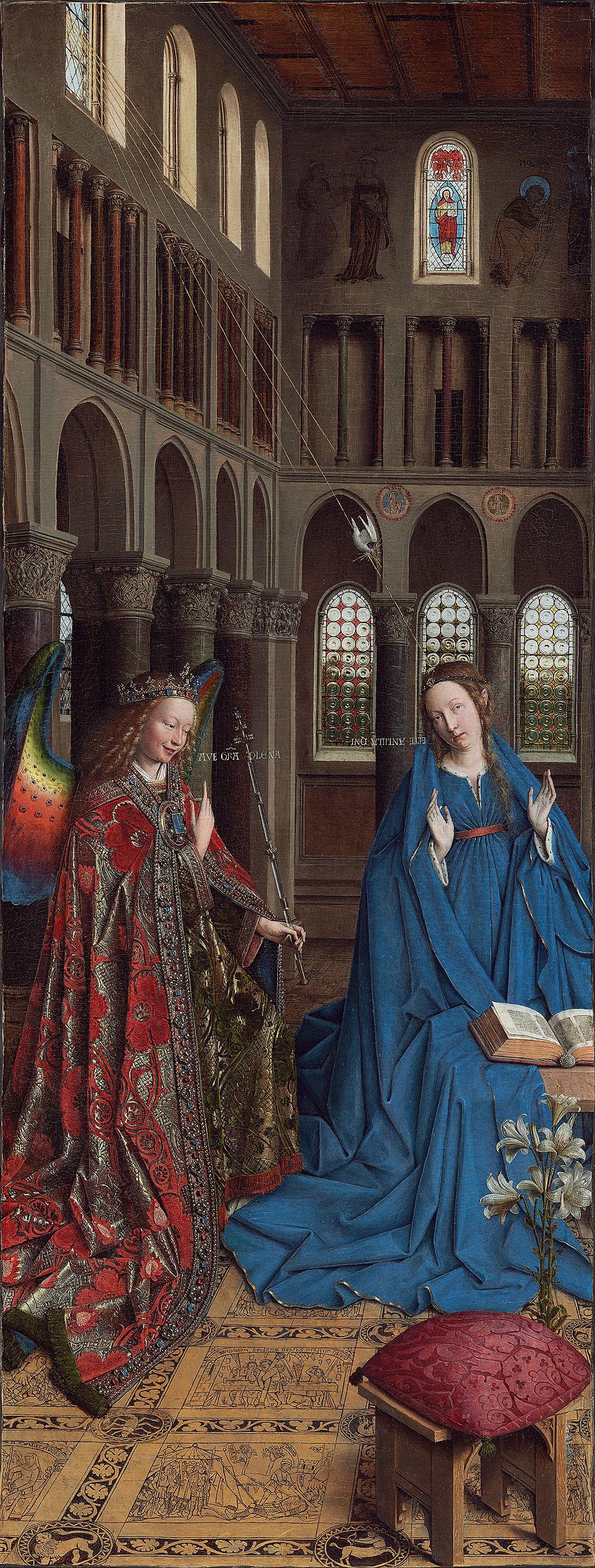
Subject Matter
In Jan van Eyck’s Annunciation scene, we see the two main characters, Archangel Gabriel to the left and Mother Mary to the right. Mother Mary holds up both her hands in a gesture referred to as expansis minibus, which indicates the emotion of surprise. This is expectedly so, as she just heard she is going to bear the Son of God.
The two figures are standing in a church setting, which is a different setting to most of the Annunciation scenes that usually take place outdoors like a portico or in a home. Some examples of the above-mentioned settings include Annunciation (1443) by Filippo Lippi, Annunciation (1450) by Fra Angelico, and Annunciation (1472 to1475) by Leonardo da Vinci.
The church setting has been suggested as intentional by van Eyck to convey a deeper message. Additionally, cathedrals like these were not in existence when Mother Mary received the news from Archangel Gabriel.

The background suggests a Romanesque and Gothic-style cathedral space. The Romanesque style is suggested by the rounded arches in the clerestory (top section) and Gothic at the bottom, suggested by the pointed arches to the left of the composition. This is also historically accurate in some sense because some cathedrals did overlap the two architectural styles. However, the church van Eyck presents is believed to be fictional.
The wooden ceiling of the cathedral appears dilapidated – we see part of the wooden planks broken out. There is one stained glass window on the top section of the rear wall, directly behind and above Mother Mary. It depicts God standing on top of a ball of the world.
Some sources suggest that this refers to the Bible verse in Isaiah 66:1, “Heaven is my throne, and the earth is my footstool”.
On either side of the stained-glass window above are painted scenes. The left depicts when Moses was found by the Pharaoh’s daughter and the right depicts Moses when he received the Ten Commandments. Furthermore, the single stained-glass window is echoed in the three glass windows below, as well as on the rear wall.
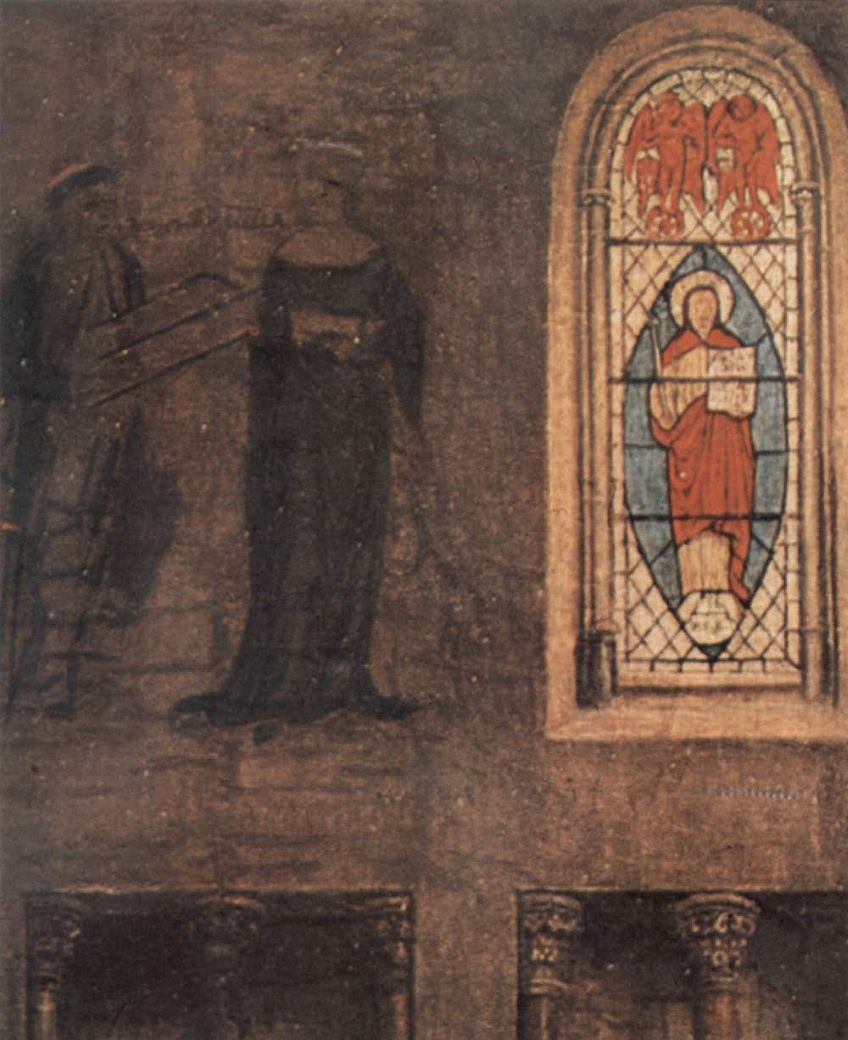
As we move downwards, there are two inscriptions next to each figure; Archangel Gabriel is saying, AVE GRÃ PLENA, meaning “Hail, full of grace”. Mother Mary says, ECCE ANCILLA DÑI, meaning “Behold the handmaiden of the Lord”. Upon closer inspection, the words are upside down because it is meant to face God, who will read it from Heaven.
When we look at the three stained-glass windows on the lower level of the church, the middle window is directly behind the figure of the Virgin Mary, almost highlighting her countenance. Furthermore, we see seven beaming rays of sunshine coming from the top side window on the left and a dove flying, all towards the Virgin Mary’s figure.
Both figures are elaborately dressed. Mother Mary wears a blue dress (symbolic of divinity) with ermine trim (ermine was used for royal garments, which suggests Mother Mary’s royalty). A small “circlet” adorns her head. Mother Mary’s stance is also a debated topic because it is uncertain if she is kneeling, sitting, or standing.
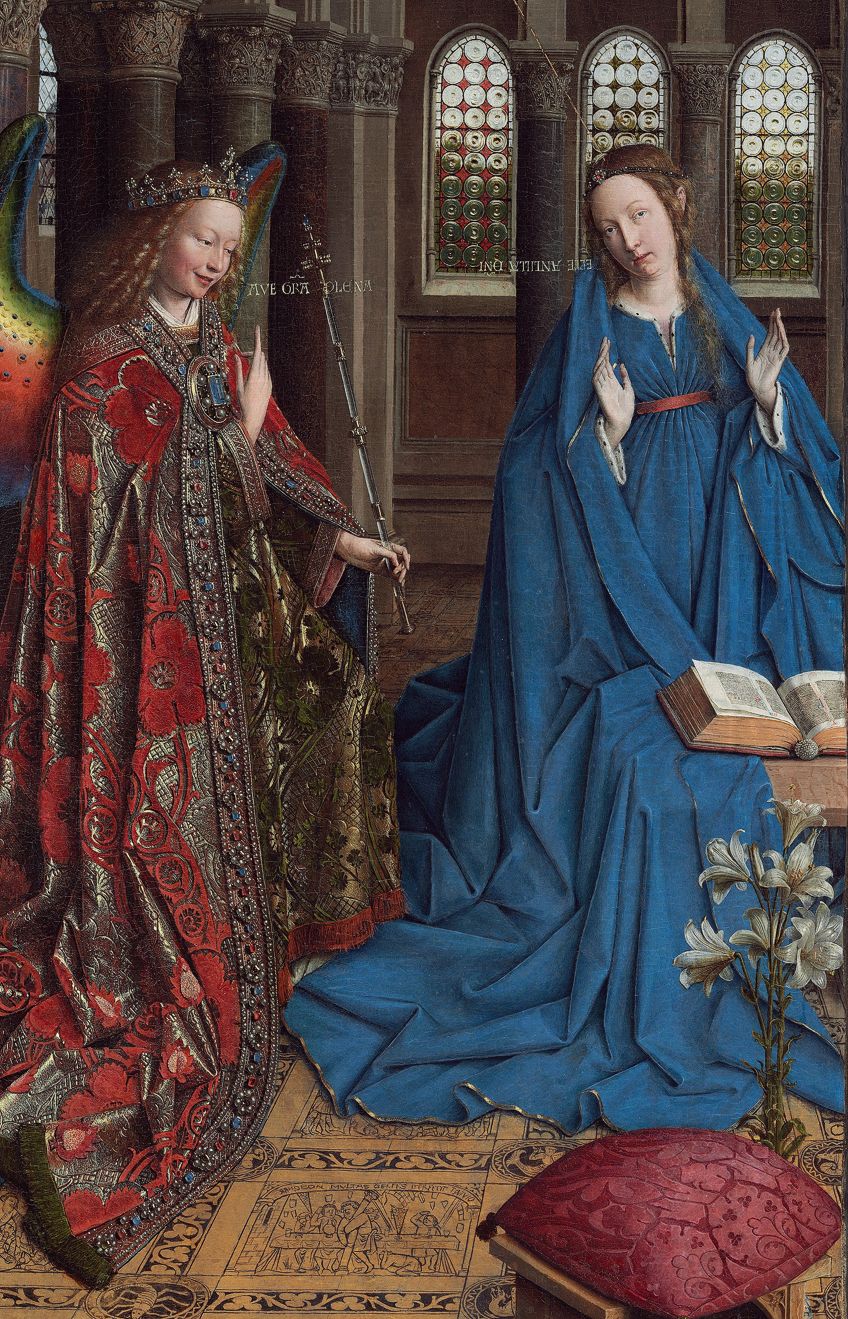
Archangel Gabriel wears a similarly styled robe to Mother Mary, except it is more lavish, decorated in patterns and large jewels. He also wears a crown and holds a staff in his left hand with his right finger pointing upwards. His garments also suggest that he is taking part in or celebrating High Mass.
The difference in clothing creates a contrast between the two figures, indicating that Archangel Gabriel is from heaven and Mother Mary appears plainer, suggestive of the contrast of Heaven and Earth. Furthermore, Mary’s facial features are believed to resemble that of Isabella of Portugal, who was Phillip the Good’s wife.
In the foreground, we notice a book, a bunch of lilies, and a footstool in the bottom right corner of the composition. The book is suggested to be the Book of Isaiah, but it can also hint at Mary’s “studious” nature.

The floor, which appears as tiles, is significantly visible in the foreground, giving us enough indication that it depicts various scenes from the Old Testament, including stories of Samson and the story of David and Goliath. There are borders around each tile and its respective scene, including foliage motifs like clovers, the columbine flowers, and Zodiac signs.
The Zodiac signs are not all visible, however. The signs that are visible include Aries, Virgo, and Capricorn. Zodiac signs were a common addition on floors or pavements of Medieval cathedrals like the one suggested in this painting.
The imagery of the Zodiac signs also points to God’s rule of the whole universe, including all things related to astrology. The creatures in the Zodiac signs could also suggest chaos before the advent of Christ.
Themes: The Old and New
Prominent themes that show up in this painting explore the concepts of old and new, especially with various references to the Old and New Testaments from the Bible. This is touching on the coming of the “new age”, so to say, with the conception and birth of Christ through the Virgin Mother Mary.
We see this echoed in the manner van Eyck depicted the cathedral inside. From the top it appears dilapidated; there are references to the Old Testament from the paintings on the top wall, and the architecture itself is from an older style (Romanesque). The whole top area of the church is also darker and seemingly shrouded in shadows.

As we move downwards towards Mother Mary, more light highlights the central figures and lower space. The architectural style (Gothic) is also newer with the windows allowing in more light. The reference to the New Testament is evident in Mary herself and the notion of Christ in human form.
She is described as an intermediary figure between these two worlds or “eras”.
The concept of the Trinity from the Bible is also evident in the placement of the windows, for example. The top single window could be hinting at God from the Old Testament and as the narrative moves into a newer realm, the three windows become reminiscent of the Holy Trinity, namely, “God the Father”, “God the Son”, and “God the Holy Spirit” – all three are God.
Symbolism: Religious Iconography
Jan van Eyck’s Annunciation painting is filled with symbolism, and for anyone who is not familiar with religious iconography, it might be confusing deciphering what it all means. Let us start with the number seven. We see this number repeated in the rays of sunshine coming in from the left and the number of lilies to the right.
The number seven refers to the Seven Gifts of the Holy Spirit, from the book of Isaiah (II: 2 to 3). The gifts are wisdom, understanding, counsel, strength, knowledge, purity, and fear.

The dove coming downward towards Mother Mary’s figure represents the Holy Spirit and is also a symbol of peace. Similarly, the lilies we see in the foreground represent purity and are also symbols of Christ. The footstool in the right-hand corner of the composition is echoed in the stained-glass window above, where God stands on a globe of the world.
This refers to the Bible verse in Isaiah 66:1, “Heaven is my throne, and the earth is my footstool”. Additionally, it may refer to an empty throne, which will be filled with the coming of Jesus Christ.
Gabriel’s wings are depicted in a variety of colors, reminiscent of a rainbow. This is the only Annunciation scene where Jan van Eyck gave Gabriel rainbow wings that appeared in this manner. The wings also look like peacock feathers, which are symbolic of immortality.
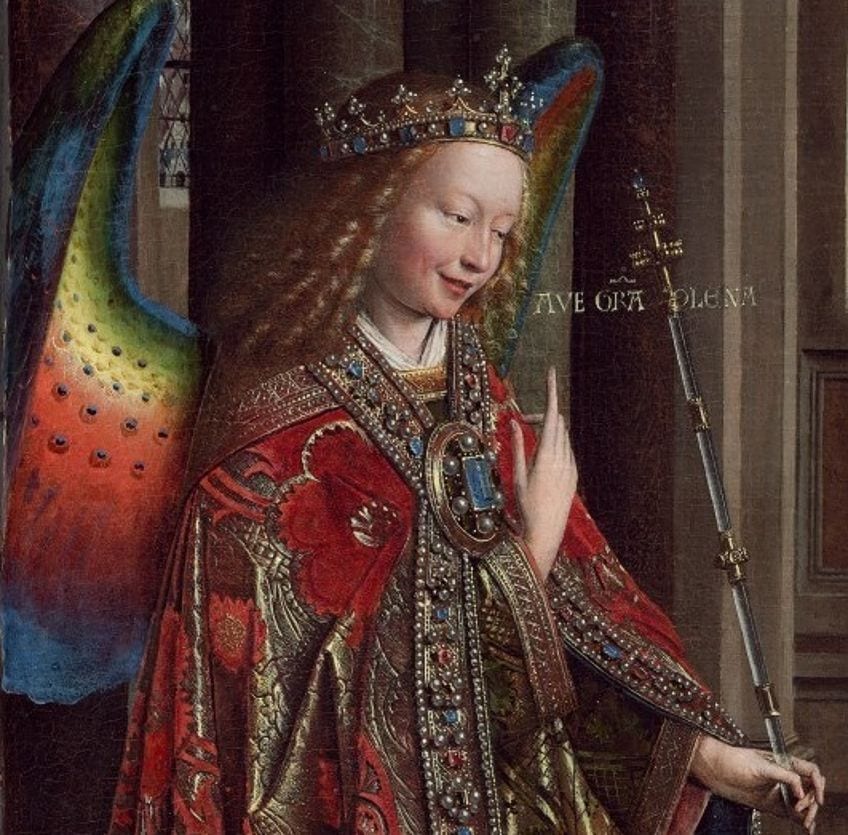
The rainbow wings in this painting allude to the Old Testament again, specifically to Noah and the Ark as well as Revelations. Some sources suggest that van Eyck alluded to the connection between Noah and Christ. This also refers to when the Archangel Gabriel intervened when Noah was alive. The rainbow becomes a powerful symbol of cleansing and purification, as we find these are strong themes from the Biblical narratives mentioned above.
Painting Technique: Color, Light, and Texture
The color comes through quite richly in the way van Eyck used his oil painting techniques. He utilized gold leaf to depict the rays of sunshine and often used the wet-on-wet technique for more texture. We see this achieved on Gabriel’s garments, which are in a brocaded style.
The jewels on Gabriel’s garments glisten with realism, hinting at the artist’s innovative usage of the oil paint medium.
He is well known for having experimented with new oil paint mixes. Some sources indicate he included linseed oil and resins into his oil paints, which allowed him to paint objects like precious stones (that we see here on the angel’s garments) and metals.
Van Eyck uses light in two ways in this painting: for natural purposes and symbolically. He creates an unknown light source in the foreground that seems to highlight the central figures. This is coupled with the symbolic light we see coming from the rays of sunshine above.
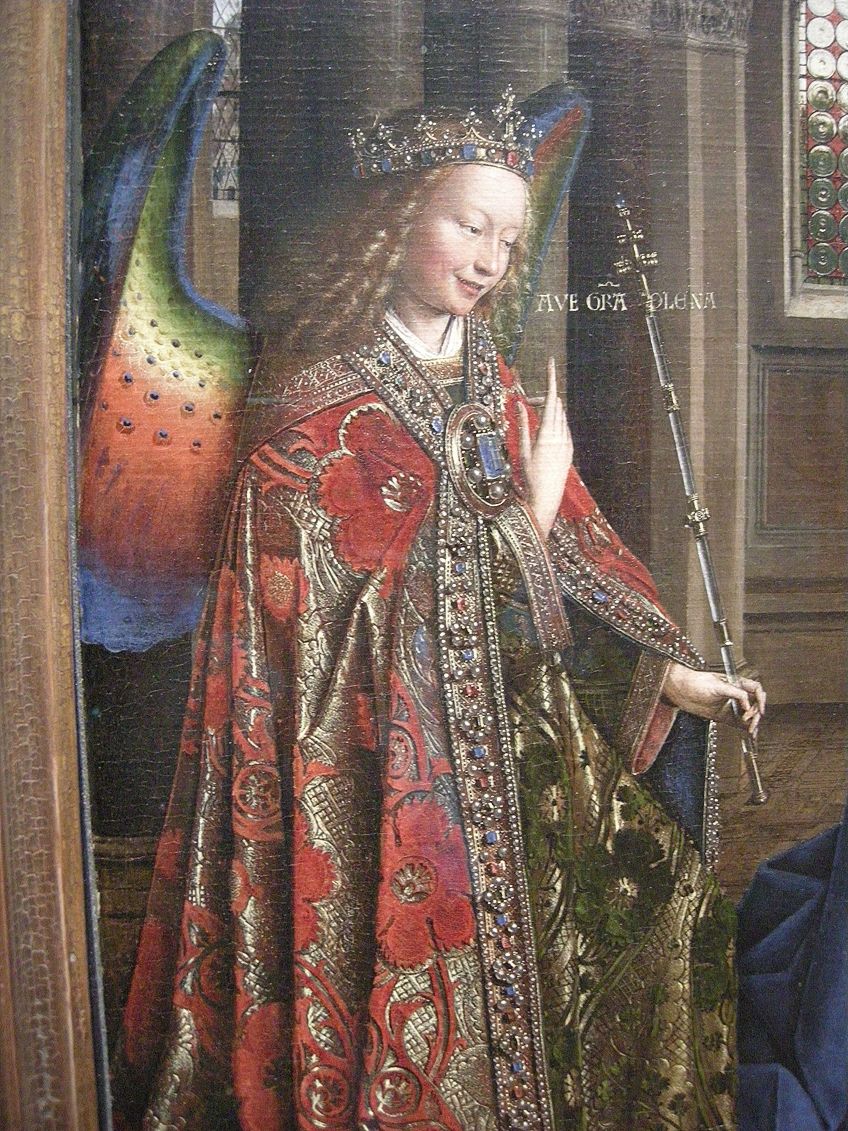
We also notice the natural light coming from the windows along the clerestory and the windows at the bottom. The light does not appear harsh in any way, but it indicates a softness from the daylight outside the church.
The entire composition is exemplary of van Eyck’s skill to depict light and shadow on nearly all the objects with his skilled use of oil paints.
A famous quote from the publication, The Story of Painting (1997) by Sister Wendy Beckett describes the “technical virtuosity” that van Eyck painted with. She states: “Van Eyck’s inspired observations of light and its effects, executed with technical virtuosity through this new transparent medium, enabled him to create a brilliant and lucid kind of reality. The invention of this technique transformed the appearance of painting”.
Perspective
The figures appear larger in size than what would be mathematically in proportion to the surrounding architecture, possibly highlighting the figures’ importance. Van Eyck also depicted the figures’ faces in the three-quarter portrait view, which simply means that only three-quarters of the face is in view. This tilting of the figures’ heads adds realism to the composition, and we can relate to their emotional states a little bit easier.
An interesting fact about this Annunciation painting is that van Eyck left behind traces of his underdrawings, which are the preparatory drawings before the painting starts. The underdrawings suggest numerous changes to the layout of the composition, including different vanishing points and perspectives.
Additionally, the pilasters to the left were planned to be repeated on the rear wall where the paint is applied thicker, suggesting that van Eyck decided to paint over it. The footstool is depicted larger than planned and the vase of lilies appears to have been included at the last minute.
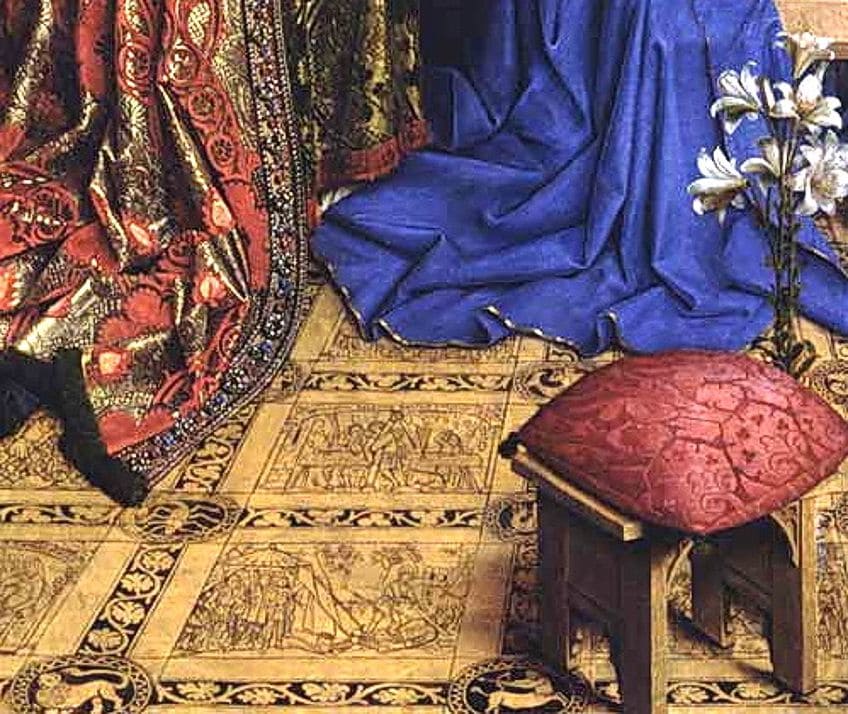
Scale
The painting measures 90.2 x 34.1 centimeters, and as stated above it was believed to be part of a triptych. This gives us an indication of the actual size and how it would have been placed in a church as part of the altar.
“As Best I Can”
The Annunciation painting described above, now housed in the National Gallery of Art in Washington D.C., United States, is a complex work of art exploring various ways that indicate the transition from the old world (Old Testament) to the new world (New Testament), and the coming of the Son of God, Jesus Christ. Mother Mary is depicted as a central figure and as the bridge between this old and new, she almost becomes the vehicle facilitating the birthing of the new world.
Jan van Eyck’s motto in life was Als ich kan, which translates to “as best I can” or “as I can”. He usually inscribed this in Greek letters on his paintings as AAE IXH XAN. He was believed to be one of the first Netherlandish painters from the 1400s to do this, if not the only painter.
With his exceptional artistic skill, the Annunciation painting is one of van Eyck’s masterpieces from Netherlandish painting during the Renaissance period, and was certainly done to the “best” of the artist’s abilities.
Frequently Asked Questions
What Is the Annunciation?
The Annunciation is also referred to as the Annunciation of Our Lady of the Annunciation of the Lord. It is based on the Christian story when Archangel Gabriel announced to the Virgin Mother Mary that she would bear the Son of God, Jesus Christ. The Annunciation scene has been the subject of numerous religious paintings and is inspired by the book of Luke (1: 26 to 38) in the Bible.
What Is Jan van Eyck, The Annunciation?
The Annunciation (1434 to 1436) is an oil painting by the Flemish artist, Jan van Eyck. It is from the Northern Renaissance period and falls under the religious, or Christian, art genre. Some believe it was part of the left-wing of a triptych panel. It depicts the famous Annunciation scene from the Bible and is now housed in the National Gallery of Art in Washington, D.C., United States.
What Does Jan van Eyck’s The Annunciation Symbolize?
The Annunciation symbolizes the transition from the Old into the New, also depicting various motifs that allude to the Old Testament and New Testament. Most importantly, it symbolizes the coming of the new age, the age of Grace, when Jesus Christ will be born. Mother Mary acts almost as a conduit of this oncoming new age. Other symbolism includes references to the Holy Trinity and the concepts of purity, regeneration, and cleansing.
Isabella studied at the University of Cape Town in South Africa and graduated with a Bachelor of Arts majoring in English Literature & Language and Psychology. Throughout her undergraduate years, she took Art History as an additional subject and absolutely loved it. Building on from her art history knowledge that began in high school, art has always been a particular area of fascination for her. From learning about artworks previously unknown to her, or sharpening her existing understanding of specific works, the ability to continue learning within this interesting sphere excites her greatly.
Her focal points of interest in art history encompass profiling specific artists and art movements, as it is these areas where she is able to really dig deep into the rich narrative of the art world. Additionally, she particularly enjoys exploring the different artistic styles of the 20th century, as well as the important impact that female artists have had on the development of art history.
Learn more about Isabella Meyer and the Art in Context Team.
Cite this Article
Isabella, Meyer, “Jan van Eyck The Annunciation – Analyzing the Annunciation Painting.” Art in Context. September 2, 2021. URL: https://artincontext.org/jan-van-eyck-the-annunciation/
Meyer, I. (2021, 2 September). Jan van Eyck The Annunciation – Analyzing the Annunciation Painting. Art in Context. https://artincontext.org/jan-van-eyck-the-annunciation/
Meyer, Isabella. “Jan van Eyck The Annunciation – Analyzing the Annunciation Painting.” Art in Context, September 2, 2021. https://artincontext.org/jan-van-eyck-the-annunciation/.




